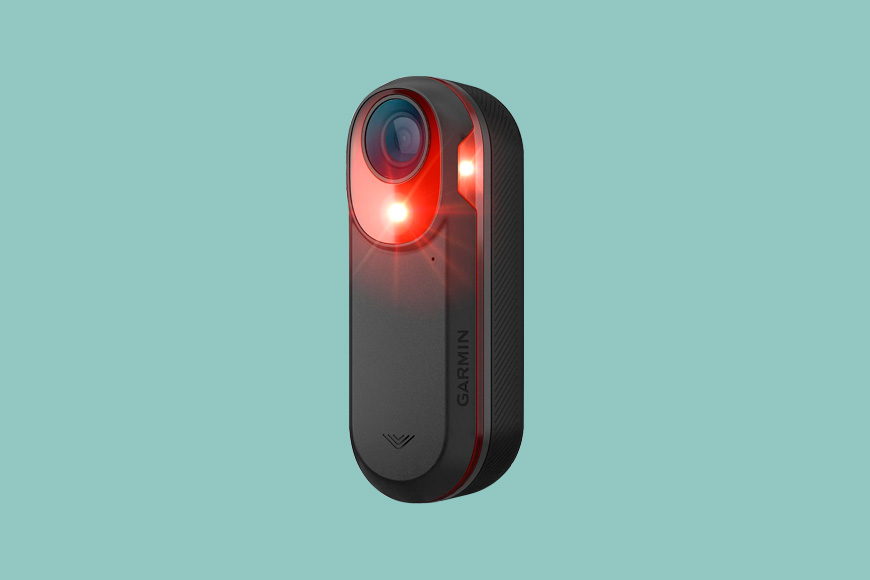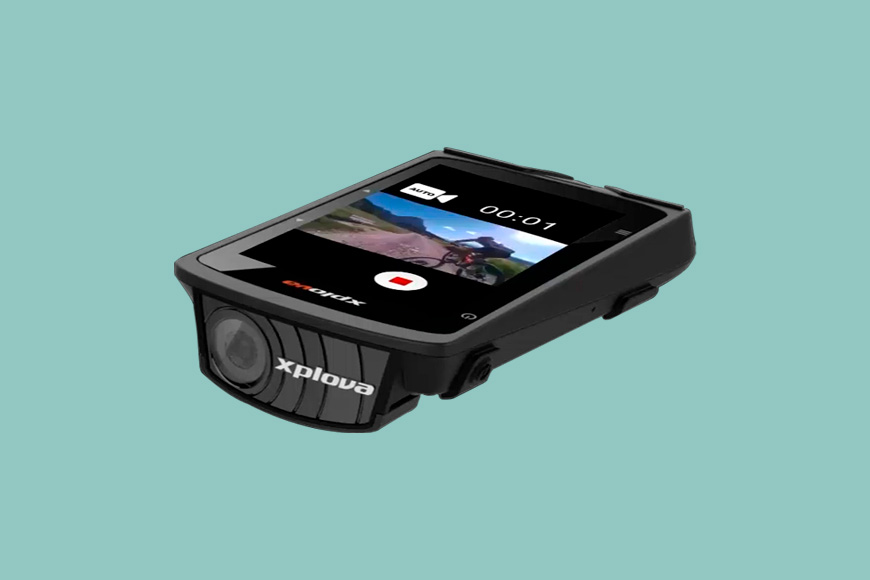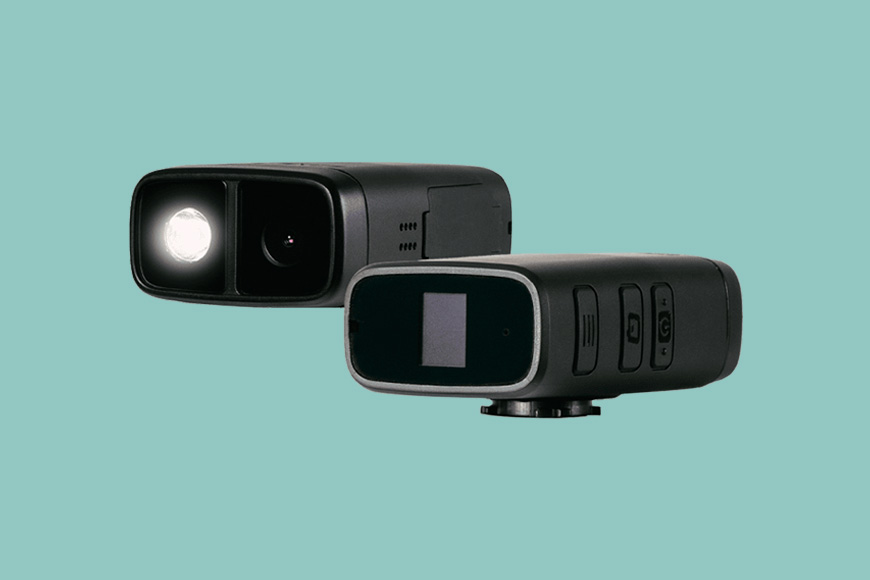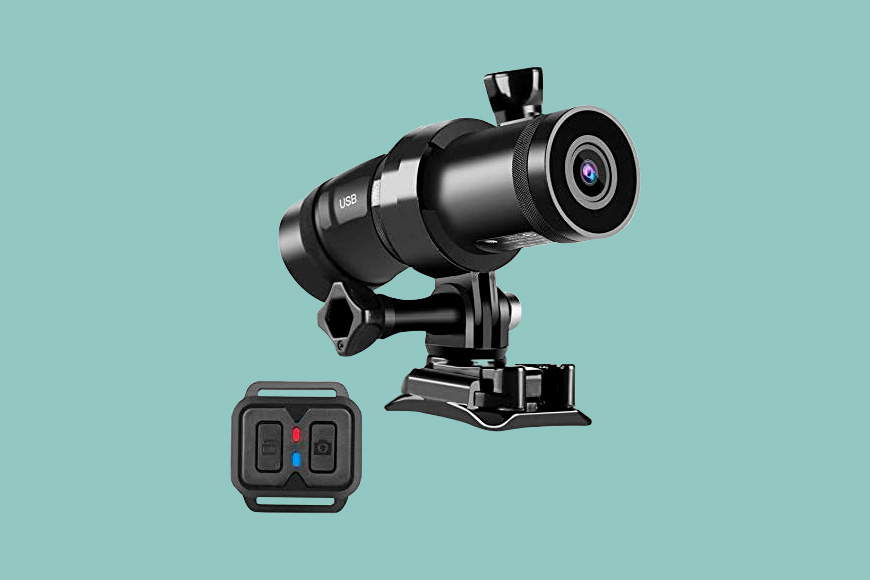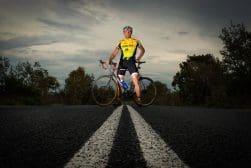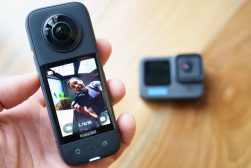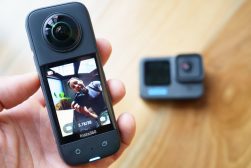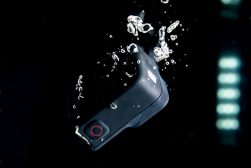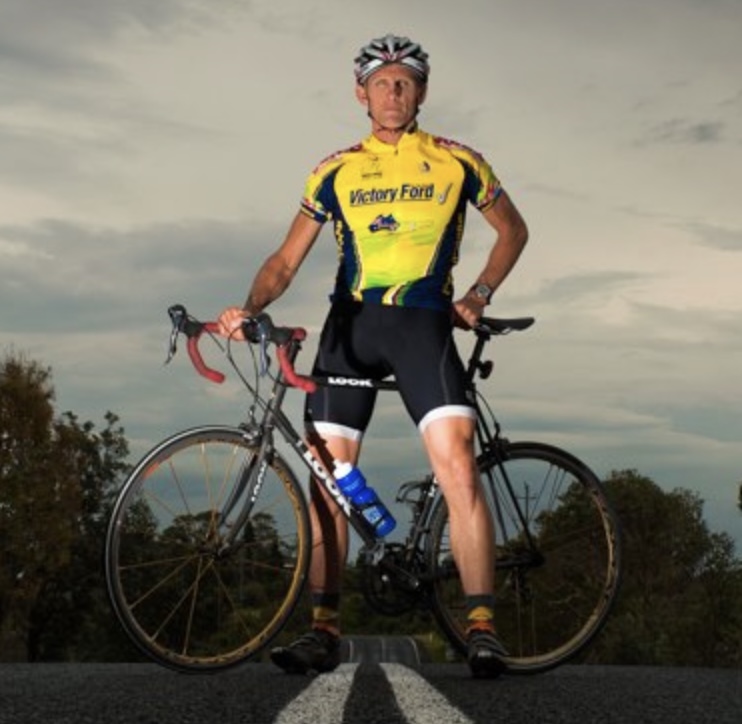
Best Bike Camera for Cyclists in 2023
Discover the top bike cameras tailored for cyclists, ensuring crisp video footage for both enjoyment and safety as you capture every moment of your ride.
Camera Gear Guides | Camera Guides | By Jeff Collier and Mark Condon
This guide to the best bike camera for cycling is a subject close to my heart.
I’ve tested a wide range of cycling cameras during my thousands of rides at home in Australia and further afield.
From action cameras to film the fastest MTB descents to cycling safety cameras to monitor road traffic, I’ve tried it all.
While I love sweating it out in the saddle, sharing cycling escapades after the ride on Strava, YouTube, or Instagram is still half the fun!
The best bike cameras can be mounted on helmets, handlebars, and seat posts – some even have ‘invisible’ selfie sticks.
With the right action camera mount, you can capture exciting video footage more easily than ever before.
Aside from taking photos of yourself and your rides, most models below can be used effectively for cycling photography too.
So whether you want to be the next cycling YouTuber or just want a way to record your rides, here are my top recommendations.
Key Features of a Bike Camera for Cycling
- High-Resolution Video: For clear, detailed recordings.
- Wide-Angle Lens: Captures a larger field of view.
- Image Stabilization: Reduces blur while cycling over rough terrain.
- Weather Resistance: Protects against rain and snow.
- Mount Compatibility: Fits securely on various parts of the bike.
- Lightweight: For easy attachment and minimal impact on riding.
- Long Battery Life: Allows for extended use during long rides.
- Night Vision or High ISO: Enables clear recording in low-light conditions.
- WiFi/Bluetooth Connectivity: Enables easy setup and file transfer.
- Loop Recording (Optional): Overwrites old footage when memory is full.
Table of Contents
What is the Best Bike Camera for Cyclists in 2023?
| Image | Product | Features | |
|---|---|---|---|
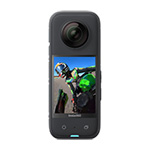 | Insta 360 X3BEST 360 DEGREE CYCLING CAMERA |
| Check AMAZON Price → Check B&H Price → |
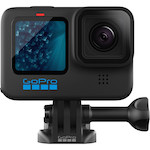 | GoPro Hero 11 BlackBEST ACTION CAMERA |
| Check AMAZON Price → Check B&H Price → |
 | Insta360 Go 3BEST FIRST-PERSON ACTION CAMERA |
| Check AMAZON Price → Check B&H Price → |
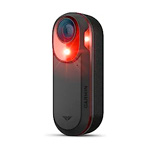 | Garmin Varia RCT715BEST REARVIEW RADAR CAMERA |
| Check Amazon Price → |
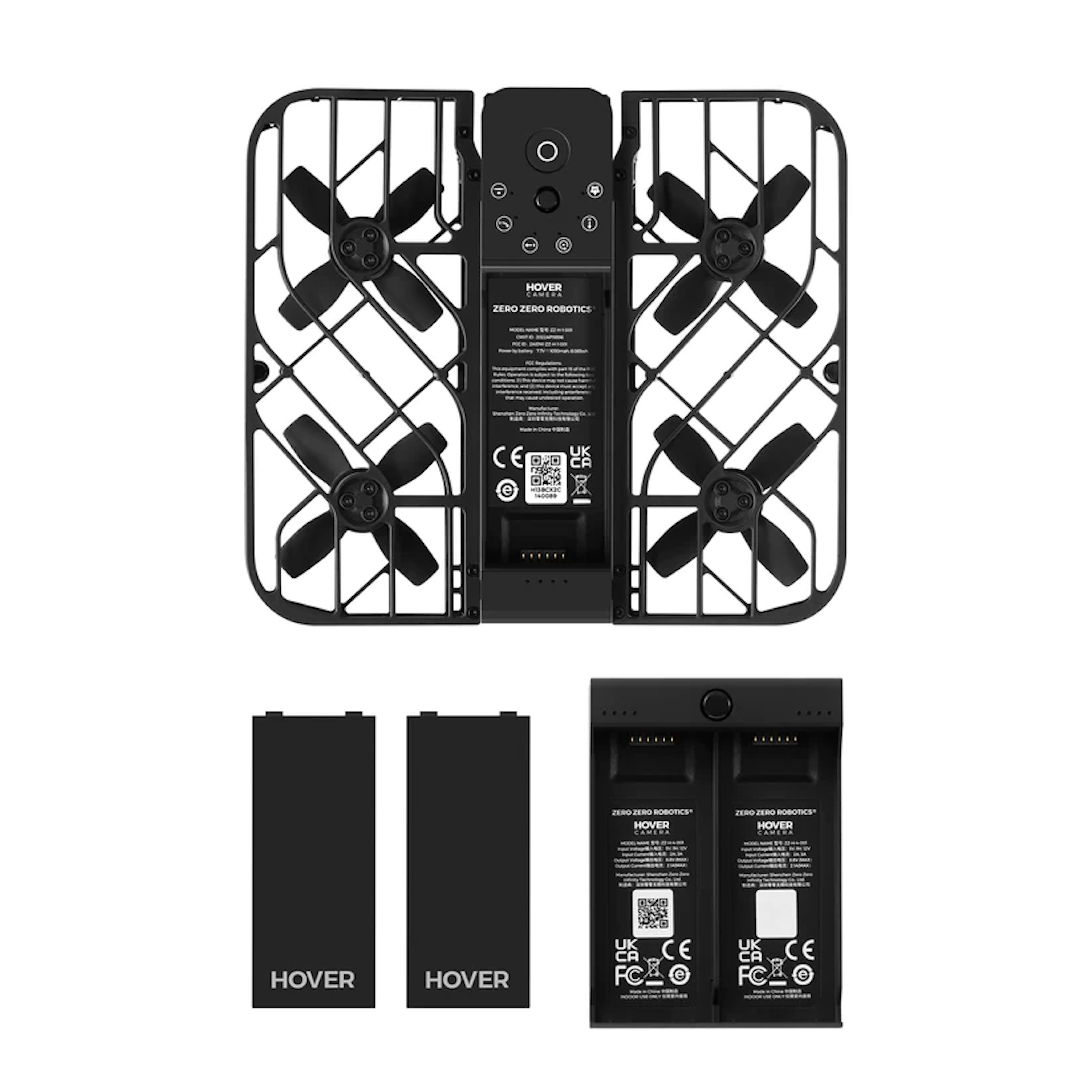 | HoverAir X1BEST CYCLING DRONE |
| Check Current Price → |
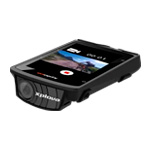 | Xplova X5 Evo BEST CYCLING COMPUTER CAMERA |
| Check XPLOVA Price → |
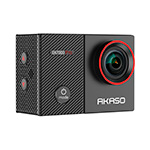 | Akaso EK7000 ProBEST BUDGET ACTION CAMERA |
| Check AMAZON Price → Check B&H Price → |
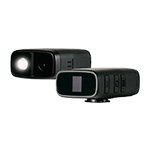 | Cycliq Fly 12 SportBEST FRONT-FACING SAFETY CAMERA |
| Check CYCLIQ Price → |
 | Techalogic DC-1BEST DUAL LENS HELMET CAMERA |
| Check AMAZON Price → |
Insta 360 X3 | Best 360 Degree Cycling Camera
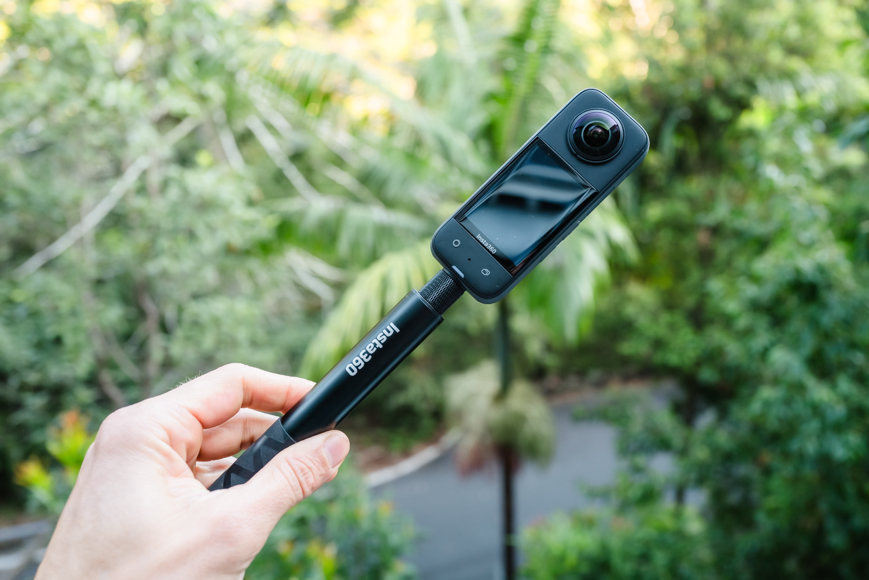
- Large touchscreen
- Powerful cycling camera
- Lightweight
- 5.7K video
- Durable and weather-resistant
- Limited bike mounting options
- Exposed lens prone to scratching
This is Insta360’s flagship cycling camera, and it’s an action camera and a 360 camera rolled into one.
It’s light and very compact, so it’s easy to clip to your body or bicycle using one of their bespoke mounts.
It’s also weather-resistant and waterproof up to 33ft. However, you shouldn’t be cycling that deep underwater…
It houses dual half-inch 48-megapixel sensors, so it can record a full 360 degrees of footage, and it can do that at 5.7K resolution. Plus, you can also take 72-megapixel photos.
Although it’s made for shooting 360 degrees, you can also switch to using a single lens to shoot wide-angle POV video, and that can be done at 4K resolution.
It also contains an amazing feature called the Invisible Selfie Stick (see above image). As each lens takes in 210 degrees of view, it creates an overlap and sweet spot where the cycling camera, if you hold it away from your body, can’t be seen.
This allows you to shoot unique cycling footage that looks like you’re being followed by a drone.
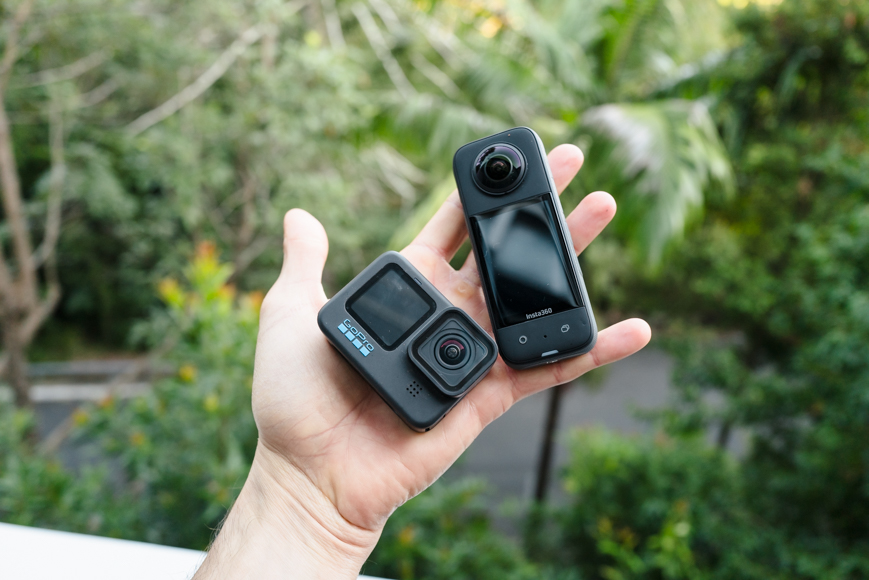
Size comparison of GoPro Hero 12 vs Insta360 X3
Footage comes out buttery smooth, too, thanks to the device’s 360-degree horizon lock and its market-leading FlowState image stabilization.
I took it out on a bumpy MTB single track where my teeth were chattering in my head, but the smooth footage from the X3 looked like I was floating.
It has a 2.29-inch touchscreen, which makes it super easy both to preview footage and navigate the menu.
Once you transfer your footage to your phone, the Insta360 app offers a range of features to help you make something special, like a photo animator and AI Storyteller that uses creative templates to help you stitch footage together.
GoPro Hero 12 Black | Best Action Camera for Cycling
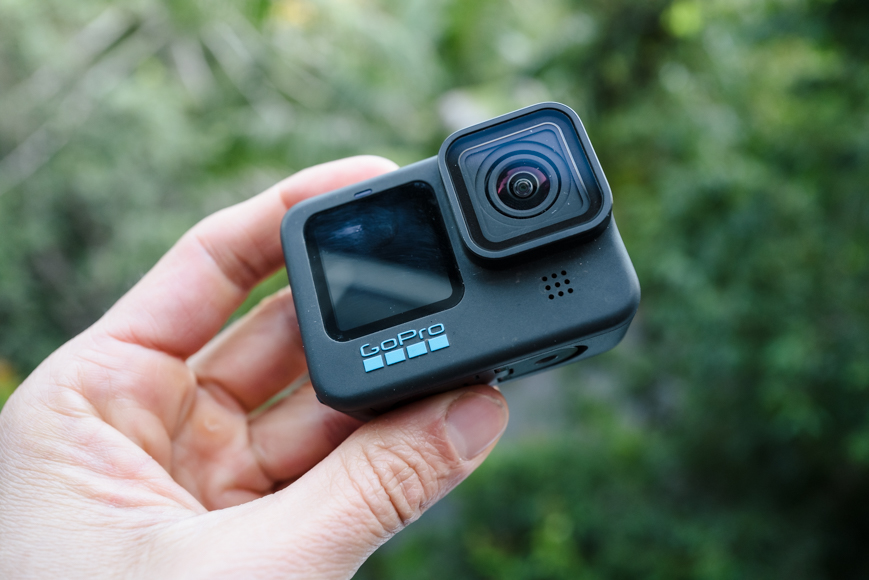
- 5.3K video
- 360-degree horizon lock
- 27 megapixel camera
- Excellent image quality
- Compatible with over 40 accessories
- Hyperview can warp view into strange perspectives
- Low light performance needs improving
Another flagship product, this time from GoPro, and it’s our number one pick among the best action cameras for cycling.
You can use it to capture footage from a first-person POV or a close point-of-view (using, for example, a selfie stick), or you can prop it on a tripod or somewhere else to film yourself and your buddies riding by.
While there are plenty of GoPro competitors around, the Hero 12 really is the best action camera of the lot, offering all the features any cyclist would ever need to film rides.
The GoPro Hero 12 Black produces 5.3K and has a 360-degree horizon lock, which means your horizons will always be level.
(This is especially useful when mounting the GoPro on your cycling helmet, ensuring your footage is completely horizontal, even when your head is inevitably not.)
It also features GoPro’s latest Hypersmooth 6.0, which is image stabilization software that makes your footage extremely smooth, however much you or the camera is wobbling.
When compared with the image stabilization of the Insta360 X3, the GoPro is marginally better, but both offer more than you’d ever need when cycling.
I mounted a GoPro to my handlebars for a recent MTB event and was astounded by how smooth the footage looked, despite the course being extremely rough.
It also comes with the Enduro Max battery as standard. This version of the GoPro battery has double the life of standard GoPro batteries, and that’s even true when using them in extreme temperatures.
Thanks to its improved power management, it delivers 2x longer continuous recording at 5.3K60 (70 minutes), which is obviously great for longer bike rides.
Some cyclists use GoPros as safety cameras (to continuously record rides in case of road accidents), so the extended battery life of the Hero12 is a great upgrade from earlier GoPro models.
Insta360 Go 3 | Best First-Person Action Camera for Cycling
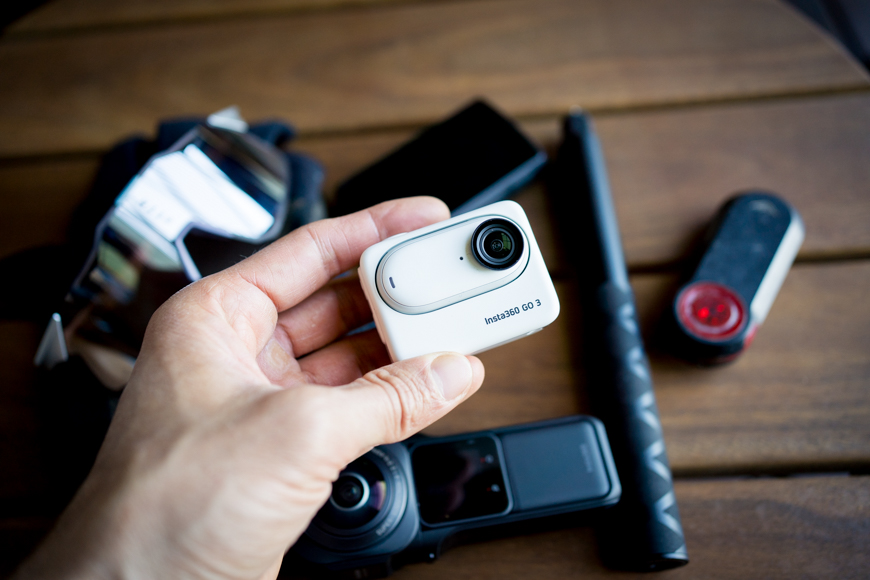
- Improved battery life
- Good image stabilization
- Splash-proof
- Very light cycling camera
- Durable and weather-resistant
- Great image quality
- Can’t expand memory capacity
- Not the best low-light performance
There are no smaller or lighter action cameras out there with this many features.
The Insta360 Go 3 weighs a mere 35 grams and is the perfect first-person point-of-view device for cycling.
These action cameras are specifically made for capturing POV footage, and that’s easy to do as you can attach them to yourself by way of the magnetic back strip and pendant – perfect to attach it securely to your cycling jersey.
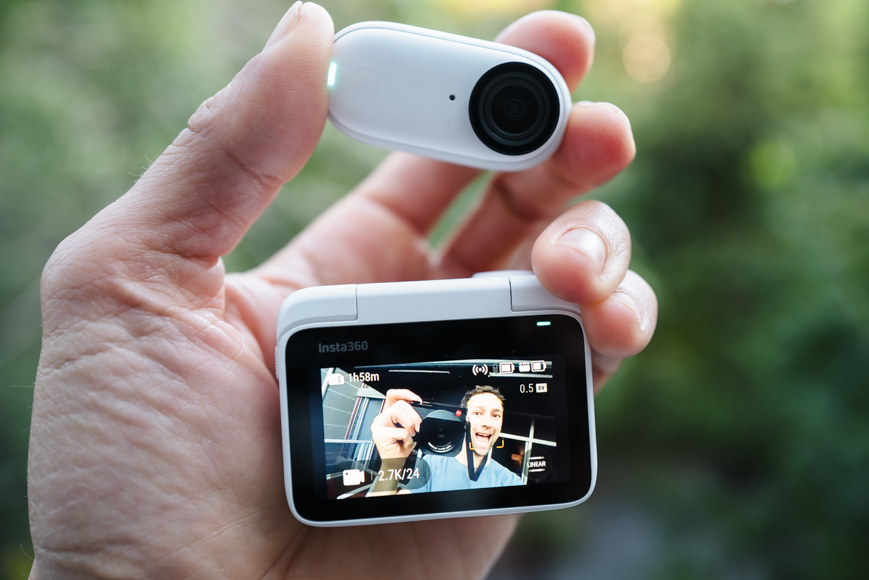
As it’s magnetic, you can obviously also attach it to anything metal, part of your bike, or, if you want to record a different point of view, something you’ll ride past.
It also comes with a clip that allows it to be mounted to a helmet, but only one with a visor like the ones used by mountain bikers.
The Insta360 Go 3 comes in an action pod that acts as a charger and also incorporates a flip-screen, which you can use to preview your footage, navigate the menu, and control the settings.
Your footage can also be previewed via your phone using the Insta360 app.
The Insta360 Go 3 shoots up to 2.7K at 30fps, and the video it produces is smooth, thanks to Insta360’s FlowState Stabilization.
It also offers you plenty of different modes, such as time-lapse and slow-motion, so you can get creative with your footage.
Editing and reframing your video, changing its aspect ratio, and more – all these kinds of things are possible to do directly in the GoPro app.
Garmin Varia RCT715 | Best Rearview Radar Camera
- Traffic detection
- Good battery life
- Bright light
- Locks accident footage
- Expensive
- The app is of poor quality
- Bulkier than the previous model
The Garmin Varia RCT715 is an excellent safety device comprised of a tail light system with a radar that detects traffic coming up behind you.
It lets you know when vehicles are approaching with a readout on your handlebar head unit. Seeing this information directly in front of you stops you from needing to look over your shoulder, an action that risks making you veer into the traffic.
One especially useful feature for group riding is the ability for other cyclists to ‘borrow’ the indication features of the Garmin via Bluetooth, allowing them to be alerted of approaching cars via their own cycling head unit.
The radar works well, and the unit also includes a cycling camera that shoots 1080p at 30fps.
However, the camera isn’t great quality. Don’t mistake it for an action camera, as it’s not – there’s no image stabilization or color profiles – the camera is really more of a safety feature.
The Garmin’s bright red light can be seen up to a mile away. It shines solid red, and when it detects a car, it starts to flash to catch the motorist’s eye.
It can also be set to Peloton Mode so that the light doesn’t blind any cyclists behind you.
The battery lasts for 4 to 7 hours, which should be enough for most rides. The Garmin also has a setting that only turns on the camera when a car is passing, which saves both battery life and memory card space.
The device pairs easily with pretty much any head unit, and it also has a USB-C port for simple file transmission.
If you don’t own a cycle computer (or it’s run out of batteries on a longer ride), you can use the Garmin smartphone app to alert you of approaching cars in a similar way.
One of its most useful features is its crash detection feature. If you have an accident, the device automatically locks that footage away and doesn’t overwrite it.
HoverAir X1 | Best Drone for Cycling
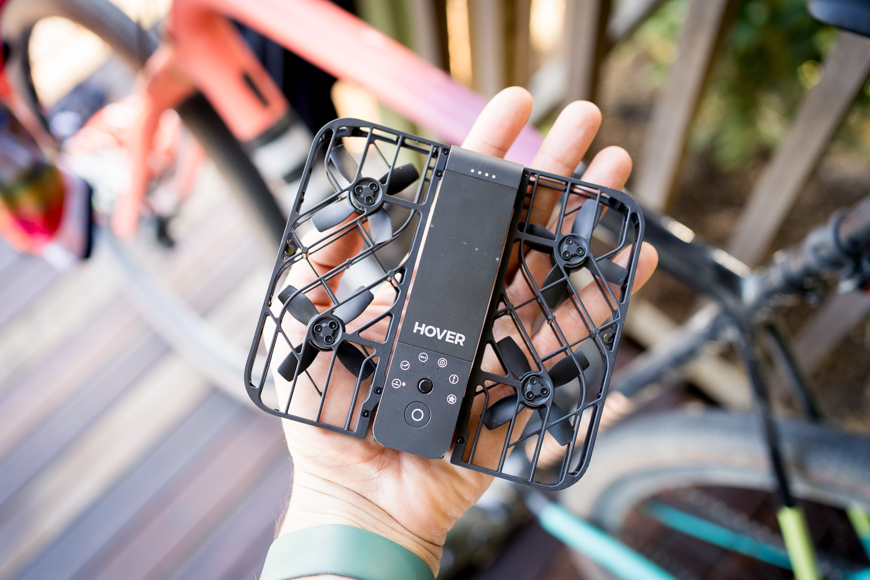
- Feather light
- Fast to deploy
- Easy to fly
- Fast video transfers
- Eerily accurate follow me mode
- Fragile
- Short battery life
For any budding cycling YouTubers, this mini drone may be the best accessory you ever buy.
The HoverAir X1 is a pocket-sized self-flying camera that allows you to film yourself when riding with minimal effort.
If you’ve ever taken a regular drone out with you on the bike, you’ll know how cumbersome and awkward the experience can become.
Even if it’s the DJI Mini, it’s still bulky enough to warrant a hip pouch or backpack, and getting it up in the air involves too much fumbling with controls and buttons.
The HoverAir X1 is so small that it can take off from the palm of your hand, with all rotors fully enclosed for safety, and at only 125g, it’s light enough to have in your rear jersey pocket on a ride and barely notice it’s there.
With the HoverAir X1, however, you can have it up and flying in a matter of seconds, thanks to the minimalistic controls mounted to the drone itself – simply press and hold a button to turn it on, then tap another to get it up in the air.
Video modes include Hover, Orbit, Zoom Out, and Bird’s Eye, but it’s the Follow feature that’s most interesting for cyclists.
With a maximum flight height of only 15m and a maximum speed of approximately 15mph, you won’t be filming any descents, but it’s still great for ambling along on your bike or climbing.

It’s so small and light you barely know it’s there.
It’s also a neat way to get a group shot at the end of your ride of all your cycling buddies from the air.
Perhaps the best feature is the lightning-fast transfer of photo and video files to the smartphone app when you’ve finished shooting.
This means you can have the footage up and on Strava or YouTube shortly after the end of your ride.
The only downsides are just how fragile it is and the short battery life of approximately 8 minutes.
However, spare batteries are cheap and feather-light too, so it’s worth investing in a couple more.
Xplova X5 Evo | Best Cycling Computer Camera
- Garmin mount
- Well-designed
- Excellent map library
- Great touchscreen
- Mount is poor
- Quite expensive
- Menus aren’t that intuitive
The Xplova X5 Evo has a 720p camera that allows you to record footage either manually or with a smart function that starts recording when you, for example, hit a certain speed or cadence.
It has a 120-degree field of view and will record in either 3, 6, or 9-second increments which can then be compiled into a longer video.
It has many of the features you’d expect from this sort of device, with GLONASS, GPS, and both a barometric altimeter temperature gauge and an ambient light gauge.
It can connect using Bluetooth to its companion app or its browser-based platform, where you can create routes or connect it to routes you’ve set up in Strava.
The Xplova has access to high-quality, free, and downloadable street maps, which makes this device great for navigation.
The device uses a Garmin mount, so it’s quite likely you can use it with mounts you already have.
The buttons are well laid out, and the touchscreen is great, quick and responsive, of smartphone quality.
Plus, it’s easy to read while riding, and the 8GB of internal RAM means that all its functions are handled well and without lag.
There’s a good smartphone app, too, to help you deal with your videos.
You can easily send files to your phone using WiFi, and then the app can be used to crop, trim, add data, and finally export the footage.
Akaso EK7000 Pro | Best Budget Action Camera for Cyclists
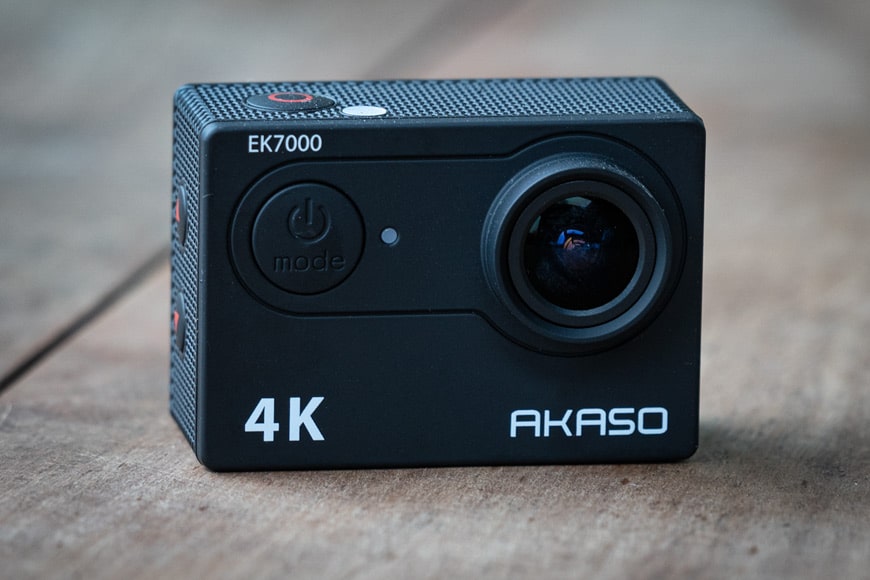
Teryani Riggs
- Shoots 4K
- Cheap action cameras
- Remote control
- Waterproof case
- Poor battery life
The Akaso EK7000 Pro is a great budget action camera for cyclists. Given its low price, it has plenty of useful features.
It’s well-built and feels solid. It has a 2-inch touchscreen display, but it also comes with a remote control. With this, you can access the basic controls of the camera from a few meters away; no need to fiddle with the buttons or the touchscreen.
I dismissed the remote control at first, but then realized I could keep it in the thigh pocket of my cycling bibs to control the camera when it was mounted away from easy reach.

All Akaso action cameras use the same mounting system as GoPro cameras | Teryani Riggs
These action cameras shoot 4K at up to 25fps, although at that resolution, there’s no image stabilization. If you want that, you’ll need to shoot at 1080p – depending on where you intend to use the footage, 1080p should be fine.
The Akaso is also capable of taking time-lapse photos and making video lapses.
It comes with quite a few accessories, including a waterproof case, and should you have any problems with it, Akaso is known for offering good customer support.
Cycliq Fly 12 Sport | Best Front-Facing Safety Camera for Cyclists
- Easy to use
- Clear footage
- Automatic footage locking
- Low light camera performance isn’t great
- Mount is a little fragile
The Cycliq Fly 12 Sport has a single, front-facing lens that records up to 4K 24 fps resolution.
However, it should be noted that 24 fps is too slow for a safety camera, so Cycliq themselves claim the optimum resolution to use on this device is 2.7K.
At 2.7K, the footage is clear, so you can easily see details such as car number plates, something that’s essential for a cycling safety device.
The unique feature of the Cycliq Fly 12 Sport is that it records on a loop, writing over previous footage. This means you never need to manually delete the footage to free up storage, as is the case with regular action cameras.
In the event of an incident, you have the option to manually lock the footage.
Alternatively, if your bike tilts at a certain angle for a specific duration, the function will automatically activate and lock the video segment at that time along with the preceding segment.
This feature enables you to review the footage and understand what occurred.
It’s very simple to set up and use, and it pairs easily with the app, and it’ll last you for a decent amount of riding, with about 7 hours of battery life.
Techalogic DC-1 | Best Dual Lens Helmet Camera
- Lightweight and stylish
- Good price
- Weather-sealed
- Easy to use
- The sound quality is poor
- Lower resolution footage
The Techalogic DC-1 records 1080p resolution footage at up to 30 fps and 720p video at up to 60 fps. And it does this to the front and the back simultaneously.
In this way, you have footage in both directions, not at action camera resolutions, not for YouTube, but plenty for safety and insurance purposes.
Its battery will give you up to 2.5 hours of recording, but make sure you charge the device from the mains with the cable Technologic supply if you want full battery life.
If you charge from a computer, a full charge will give you much less than the maximum capacity.
It’s very simple to use, with just one button to control everything, or you can use the remote control it comes with.
It also conveniently has a GoPro-style mount and also comes with a cycle helmet strap and cycle hat elasticated strap if you’d prefer to attach it to those.
It’s rugged and well-designed, with a weather-sealed micro USB port and weather-sealed microSD card port too.
Why Are The Cameras We Selected Good for Cycling?

These cameras are good for cycling for different reasons.
Some of them, like the Insta360 X3 or the GoPro Hero 11 Black, are good for cycling because, as action cameras, they allow you to shoot high-resolution footage and slow-motion video of your rides.
They also contain ground-breaking image stabilization, which means that even if you’re mountain biking on rough and rocky trails, your footage is still going to come out smooth.
Other cycling cameras are good because they provide you with safety and security.
An alarming amount of cyclists are injured and killed each year in traffic accidents.
Having a security camera along with you means footage can be used as evidence to prosecute reckless drivers and can also be used when submitting insurance claims.
All of the devices in this guide have a camera, most of them with a single lens, and one of them, the Techalogic DC-1, with a dual-lens to film in both directions.
The Garmin Varia RCT715 not only has a camera, but it also houses a radar and a light to keep you safe on the roads.
The radar scans the road behind you and lets you know when there’s a vehicle approaching, its distance from you, and the speed it’s traveling.
And its light makes you visible while also flashing to make drivers aware of you.
Other cycling cameras also double as navigation devices.
For example, the Xplova X5 Evo has a comprehensive library of free maps. Plus, you can also use it to create routes, or you can sync your Strava routes with the device.
Where Should You Mount a Cycling Camera?
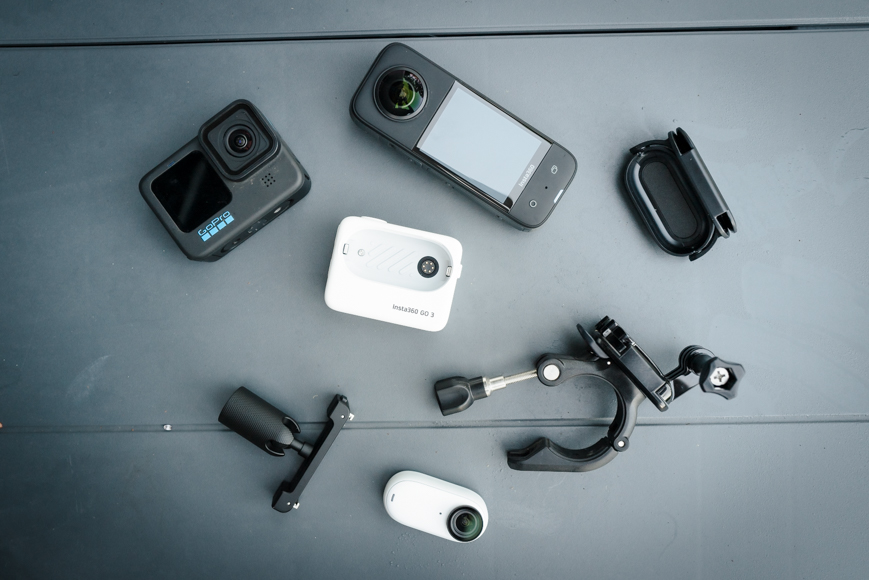
Action cameras with various mounts for bikes.
If you’re using an action camera on your bike, I recommend you experiment with various mounting placements.
I usually have mine mounted to my handlebars for ease of access, but admittedly, this doesn’t provide very interesting or immersive viewing.
Handlebar Mount
The most popular place for cyclists to mount their cameras is on the handlebar, as it’s generally easy to attach cameras securely to this part of the bike.
Plus, handlebars provide a stable platform, keeping footage at an even level while also helping to reduce vibrations.
The only real downside to attaching your camera to the handlebar is that your body is going to block a rear-facing camera, so in terms of safety, it’s not the best place. But, for cycling, it’s a great spot.
Helmet Mount
Attaching a camera to your helmet helps you capture your ride from a truly first-person perspective.
You can put it on either the top or the side of your helmet to provide that kind of dynamic first-person point-of-view. What the viewer sees is what you saw.
Mounting a camera on a helmet offers great stability on rough terrain, as the camera is connected to your body rather than the bike.
However, it can feel a little strange to wear a camera on a helmet, and for road cycling, it may interfere with your aerodynamics.
Chest Mount

Chest mounts provide an immersive viewing experience.
You can attach cameras to your chest, normally with a harness or strap that you wear across your chest, or, in the case of the Insta360 Go 3, by locking it to a magnetic pendant.
Chest-mounted cameras enable you to capture first-person POV footage from a lower angle and can provide a more immersive experience with the cyclist’s hands in the shot.
Also, as the camera is attached to your body, you can easily forget about it, as they don’t interfere with your movement.
However, chest mounts aren’t necessarily the most stable, and the harness can become uncomfortable on longer rides.
Fork Mount
Another place you can mount a camera is on the bike’s fork.
That’s a stable place to attach one and a point of view that gives you a level horizon and minimal vibration.
They’re particularly fun for cyclist looking for interesting, low-angle perspectives while having the camera well out of the way of their body movements.
However, one inherent risk with this placement is if you crash or if you are, for example, mountain biking on narrow trails where the camera may get knocked off without you noticing.
Seatpost Mount
Putting a camera on your seatpost gives it stability and is ideal for capturing footage that shows the surroundings.
They’re less stable than handlebar mounts, but if you use the same saddle with multiple bikes or are prepared to purchase multiple mounts for your other bikes, this is the way to go.
For some cycling cameras like the Garmin Varia, this is the only place it can be mounted.
Bite Mouth Camera Mount
For recording short video clips on a bike with an action camera, you should also consider a mouth camera mount.
These work best with GoPros – you simply bite on the rubber section of the mount, allowing you to record footage from face-level of your fastest descents or scariest single-track adventures.
The only downside is comfort – it’s difficult to breathe heavily while using one, and your jaw gets fatigued surprisingly quickly.
Point to the front or back?
For action, unless you specifically want to film friends behind you, the best is, wherever you mount the camera, to have it pointing to the front.
For security, the ideal is to have two cameras, but if you only have one, point it to the back.
This is because your rear is obviously your biggest blind spot, and statistically, the worst collisions for cyclists come from behind.
FAQs about cycling cameras
Why is it important to have a camera while cycling?
Cycling cameras serve multiple purposes. They’re great for capturing footage of scenic routes or competitive races, which you can later share or enjoy yourself. They can also serve as evidence in case of an accident or incident, which can be particularly useful in urban cycling environments.
Can bike cameras record sound?
Yes, most bike cameras are capable of recording sound. However, keep in mind that the audio quality may not be the best due to wind and road noise while cycling. Some models come with wind noise reduction features which can help improve the sound quality.
Can a bike camera be used in the rain?
Yes, many bike cameras are designed to be water-resistant or waterproof. However, it’s important to check the specific model’s rating and capabilities to ensure it will stand up to your riding conditions.
Can I use a GoPro as a bike camera?
Absolutely, GoPro cameras are a popular choice for cyclists. They’re compact, offer high-quality video, and come with a variety of mounts for attaching them to your bike or helmet.
How do I prevent the theft of my bike camera?
It’s best to remove the camera from your bike when leaving it unattended. If that’s not possible, some cameras have a locking mechanism for extra security.
Do cycling cameras have night vision?
Some high-end cycling cameras come with low-light or night vision capabilities. This feature can be useful if you frequently ride in the dark.
How do I maintain my bike camera?
\Keep your bike camera clean and dry when not in use. Regularly check and update the firmware if necessary. If your camera uses rechargeable batteries, make sure to charge them according to the manufacturer’s instructions.
How long can a bike camera record?
This depends on the specific model, battery life, and the quality of recording. For instance, a camera recording at 4K will consume more battery than one recording at 1080p. Generally, on a full charge, many bike cameras can record continuously for about 1.5-2 hours at high resolution. Some models may offer extended battery life.
Are bike cameras waterproof?
Many bike cameras are indeed designed to be waterproof or at least water-resistant, making them suitable for use in all weather conditions. However, the level of water resistance can vary between models, so it’s important to check the product’s specific details before purchase.
Can bike cameras be used for other activities?
Absolutely! While they are designed with cyclists in mind, bike cameras can often be used for a range of other outdoor activities, such as hiking, skiing, or even water sports, depending on the model and its durability features.





